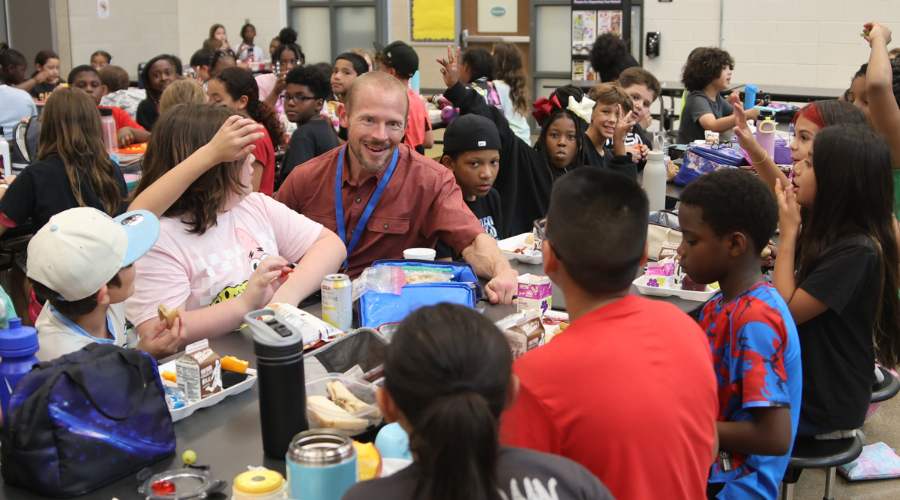Trustees Play Pivotal Role with New Superintendents
Being the new kid in school is never easy. There are the inevitable worries about making new friends and fitting in, at any age. Very often, how a new student navigates those first few nerve-racking days can impact their entire experience with the school. The same can be said about superintendents transitioning into a new district.
“I try to make each transition better than the last,” said Quintin Shepherd, who took over last year as superintendent of Pflugerville ISD, a district of 25,000 students north of Austin. “This is my fifth transition.”
How a superintendent approaches his or her role in a new district varies by experience, personality, and the needs of the district itself. However, the onboarding process for an incoming superintendent can help determine their success as a leader and the school board can play a pivotal role in creating that positive environment.
Doing the Research
The job of superintendent is varied and complex. According to a report released in November 2023 by The University of Texas at Austin College of Education, Untapped Talent: An 11-year Analysis of the Texas Superintendent Workforce, “Each superintendent works in a unique organizational position accountable to numerous stakeholders.”
Superintendents serve not only students, district staff, and families, but they are accountable to their school board, the state education agency, university partners, and nonprofit organizations. That mix of stakeholders includes the larger community, local businesses, and civic organizations. “Like corporate CEOs, superintendent leadership is highly contextualized and situated within a unique organizational, economic, and political environment,” the report stated.
For Shepherd, the transition for a new role starts by gaining an understanding of those stakeholders — even before he gets the job. “The work for the transition begins the minute you apply for the job,” he said. “Even if you don’t end up getting that job, you’ve already started the transition process.”
Applicants start by studying the district and doing their research. “You can learn so much about the district before ever stepping foot in the district,” Shepherd said.
It’s not just about looking at the district website. Shepherd recommends digging deeper and envisioning yourself and your family in that community.
For the new Goldthwaite CISD superintendent, the location was critical for his family. “My situation is very unique,” Christopher Bailey said. “This is the only job I applied for.”
Bailey was working at Abilene ISD as an administrator and aspired to take on a superintendent role. With some encouragement from his superintendent, he applied for the job at Goldthwaite CISD — but not before he did his due diligence.
Research is important for trustees, too.
“I think we all started Googling superintendents,” Renae Mitchell, Pflugerville ISD board president, said about the district’s early steps in the hiring process. “Dr. Shepherd showed up in my searches twice.”
Mitchell said the board was looking for mature leadership, someone with five to 10 years’ experience from a district that had shown growth. Shepherd had that kind of experience leading Victoria ISD and districts in the Midwest. “We were looking for the right fit,” Mitchell said.
William Foster agreed. The Caldwell ISD board president discussed his district’s search for a superintendent on a panel during txEDCON24.
“The fit is probably the biggest thing when you are looking for your superintendent. Not just what they’ve done and their experiences, but how they are going to fit in the community.” Caldwell ISD is a growing district of about 2,000 students 80 miles east of Austin.
Building Trust
Ensuring a positive onboarding experience with a new superintendent begins as early as the recruiting process.
During the interview stage, the board and superintendent candidates have the opportunity to get to know each other and to build a connection. This is a time when both parties get a preview of the future working relationship the team of eight may have.
“This board did as much of their process and [shared] information in open session as they could,” Bailey said about his interview process with Goldthwaite CISD. “And so that part of it really made me comfortable as an applicant, saying, ‘yeah, I think that I’d be willing to kind of put myself out there and take that risk.’”
Because the board was transparent about what it wanted in its next superintendent and also about the search firm hiring process, Bailey said all the information he had access to allowed him to prepare effectively. In addition, he and his wife quickly fell in love with the community of 500 students about 90 miles west of Waco.
Maintaining transparency is important not only for candidates, but also for community members, said George Kazanas, TASB Executive Search and Field Services officer.
“We want it to be transparent, we want it out there,” Kazanas said. “We want your community to know what is occurring regarding the search, not just who the candidates are but also what is going on.”
This sets the stage for building trusting relationships in the district and throughout the larger community once a superintendent is hired. TASB’s Executive Search Services led the search for a new superintendent in Goldthwaite. Working in tandem with the board is critical throughout the process, Kazanas said.
Mitchell stressed the importance of also keeping the trust of district staff during the superintendent hiring process.
“One of the most important things during a search is reassuring staff that their roles and contributions remain valued and secure as we, the trustees, work through the process of hiring a new superintendent,” she said. She and her fellow Pflugerville trustees made a conscious effort to convey consistent leadership to district employees through the board and the interim superintendent.
Learning the Landscape
While the interviewing process is intense, the real transition work starts when a superintendent is hired. “Now everything you do is being scrutinized,” Shepherd said, adding that especially includes social media. “When a new superintendent comes in, you can’t make the mistake of not recognizing that you cast a very long shadow on the district. Every word, every action is scrutinized in minute detail.”
Shepherd said there can be the temptation for new superintendents to feel like they must come in and prove themselves or “make a big splash. They feel the need to prove that they are a capable superintendent, that they know the answer and can lead with authority.”
He recommends a different approach. “You have to go with a humble heart and a vulnerable spirit and take your time.”
Sylvester Vasquez, Jr., the Southwest ISD board president, has been through five superintendents in his 24 years on the board of the growing district outside of San Antonio. He recommends that boards focus on getting to know the new superintendent and fostering relationships within the community.
“Show your superintendent off for the first 12 months and hang out with them,” said Vasquez, who is also a past president of TASB. “It’s a process. Take change slowly and get to know each other.”
Southwest ISD Superintendent Jeanette Ball agreed. “I think what’s really important is to take the time to learn your board’s expectations, what the board expects from you,” said Ball. “I can tell you in all three superintendencies, each board is very unique and very different. What worked at one district is not necessarily going to work in the next district. It takes time to transition.”
Whether the district is large or small, having open channels of communication between the board and the new superintendent can make a difference.
“What every superintendent recognizes that maybe the board doesn’t about the transition into a superintendency is you are superintendent 24/7,” said James Barton, Caldwell ISD superintendent, who is in his third year of his first superintendent’s role. “Wherever you go and whatever you do — especially in a small, interconnected town — everybody knows it. They are going to talk to you about school wherever you are.”
For that reason, the Caldwell board president stressed the importance of a new superintendent knowing the context behind community concerns.
“Dr. Barton came in and started meeting with each board member each month,” Foster said. “In fact, it was so successful that we put that in board policy.”
The best practices for governance, such as having regular meetings with board members, line up with what is written in the education code. BAA and BJA policies outline the roles and responsibilities of superintendents and trustees.
“When [superintendents and the board] commit to those roles and responsibilities, you are practicing some of the best governance possible,” said Orin Moore, senior board development consultant with TASB’s Board Development Services. He encourages the boards that he works with to revisit the documents that outline those particular policies for a district.
While understanding roles and responsibilities is a key ingredient to successful onboarding, it’s also important to allow a new superintendent time to learn the district.
“The board has to give the superintendent a little space to figure out and map the system,” Shepherd said.
Mitchell stressed that new superintendents need to be on campuses. “You have to understand the landscape. You have to step back and listen,” she said. The board particularly appreciated the 100-day listening tour Shepherd embarked on as soon as he started his new role in Pflugerville. “He was humble and just getting the lay of the land before he started to provide his own landscaping, if you will.”
Finding Unbreakable Connections
“I always take the approach of trying to make unbreakable connections right out of the gate,” Shepherd said.
He believes in a three-part formula for building relationships as a new superintendent that includes safety, connection, and a shared future.
“I’m not coming in and upending programs. I’m not firing anyone. I’m not bringing people in with me,” Shepherd said about the intentional ways he wanted students, staff, and the community to feel safe. His 100-day listening tour reached a wide audience throughout the district and became an instrument to build connections and a shared future.
“All I’ve been talking about is, ‘I can’t wait to get started building a strategic plan. I can’t wait for you to tell me the work that needs to be done.’ So, I’m trying to build this ‘we' mentality.”
Mitchell praised Shepherd’s approach and the team of eight’s overall collaborative efforts.
“I always look at my position as my community elected me to work with the superintendent and the district,” she said. “Even though we are the boss of the superintendent, it’s very important to work with that person and be that true team of eight. As board members, we are not normally educators or have worked in the school system itself. So, it is very important that we pair our community knowledge and expertise that we all bring to the board with the superintendent’s expertise. He has internal knowledge and focus while we have external knowledge and focus that can help the system.”
Beth Griesmer
Beth Griesmer is a senior communications specialist for TASB.
Mary Ann Lopez
Mary Ann Lopez is a senior communications specialist for TASB.





